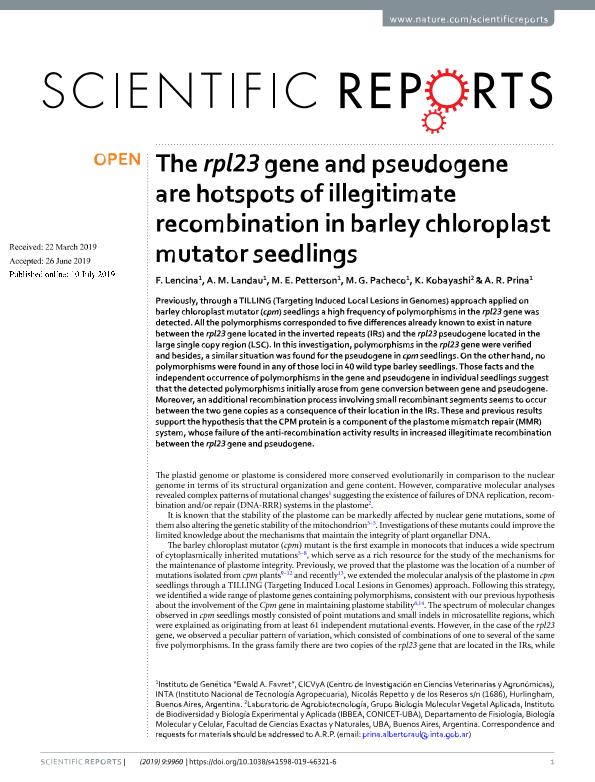Artículo
The rpl23 gene and pseudogene are hotspots of illegitimate recombination in barley chloroplast mutator seedlings
Fecha de publicación:
07/2019
Editorial:
Nature Publishing Group
Revista:
Scientific Reports
ISSN:
2045-2322
Idioma:
Inglés
Tipo de recurso:
Artículo publicado
Clasificación temática:
Resumen
Previously, through a TILLING (Targeting Induced Local Lesions in Genomes) approach applied on barley chloroplast mutator (cpm) seedlings a high frequency of polymorphisms in the rpl23 gene was detected. All the polymorphisms corresponded to five differences already known to exist in nature between the rpl23 gene located in the inverted repeats (IRs) and the rpl23 pseudogene located in the large single copy region (LSC). In this investigation, polymorphisms in the rpl23 gene were verified and besides, a similar situation was found for the pseudogene in cpm seedlings. On the other hand, no polymorphisms were found in any of those loci in 40 wild type barley seedlings. Those facts and the independent occurrence of polymorphisms in the gene and pseudogene in individual seedlings suggest that the detected polymorphisms initially arose from gene conversion between gene and pseudogene. Moreover, an additional recombination process involving small recombinant segments seems to occur between the two gene copies as a consequence of their location in the IRs. These and previous results support the hypothesis that the CPM protein is a component of the plastome mismatch repair (MMR) system, whose failure of the anti-recombination activity results in increased illegitimate recombination between the rpl23 gene and pseudogene.
Palabras clave:
cloroplastos
,
plastoma
,
mutador
,
cebada
Archivos asociados
Licencia
Identificadores
Colecciones
Articulos(IBBEA)
Articulos de INSTITUTO DE BIODIVERSIDAD Y BIOLOGIA EXPERIMENTAL Y APLICADA
Articulos de INSTITUTO DE BIODIVERSIDAD Y BIOLOGIA EXPERIMENTAL Y APLICADA
Citación
Lencina, F.; Landau, A. M.; Petterson, M. E.; Pacheco, M. G.; Kobayashi, Ken; et al.; The rpl23 gene and pseudogene are hotspots of illegitimate recombination in barley chloroplast mutator seedlings; Nature Publishing Group; Scientific Reports; 9; 1; 7-2019; 1-13
Compartir
Altmétricas




